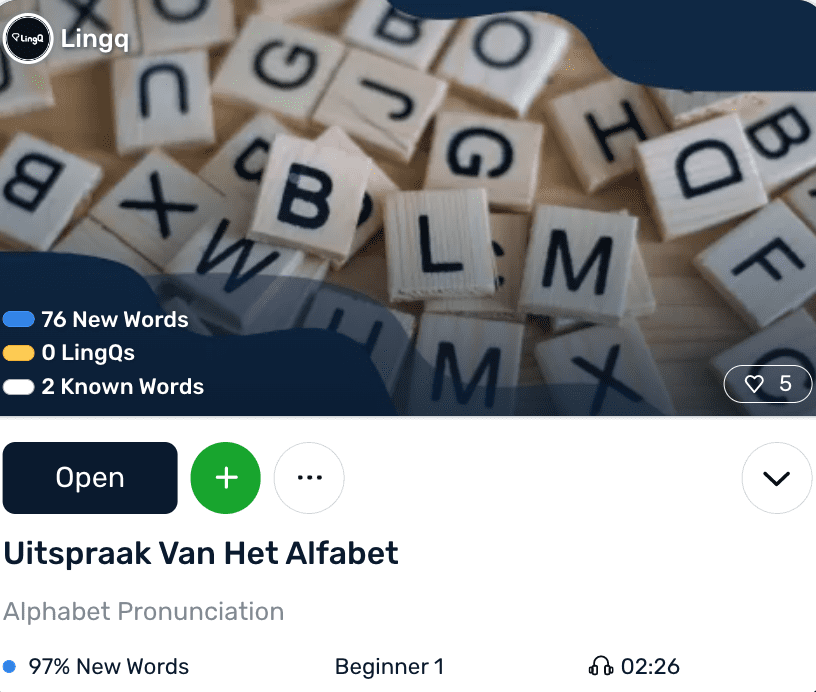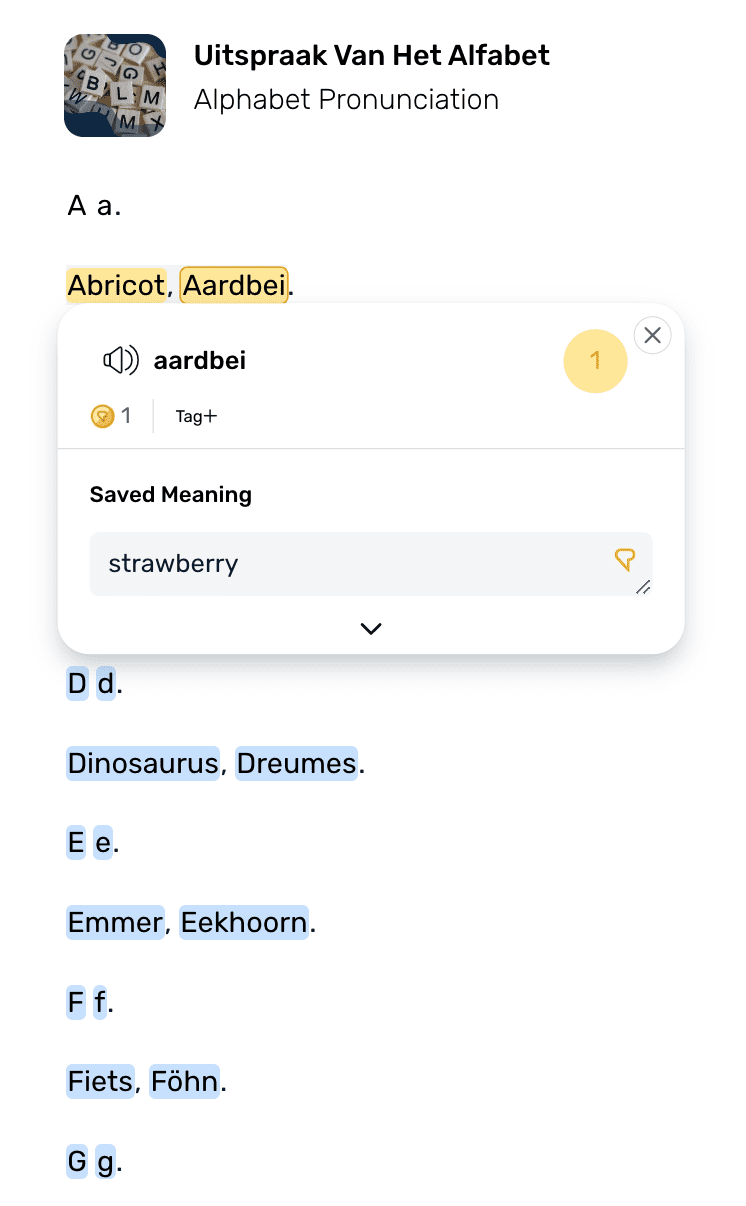The Dutch Alphabet: All You Need to Know
If you’ve studied any foreign language before then you already know that languages that use the same letters often don’t use them the same way. In this post we’ll explain everything you need to know about the Dutch alphabet. That includes how to pronounce didn’t letters, sounds that don’t exist in English, and the mystery of the infamous Dutch ‘g’.
For those who want to try their hand at learning Dutch, we have good news! For the most part the Dutch alphabet is written very consistently. Other than loanwords, you can easily predict the pronunciation of any given word just by looking at how it’s spelled.
The Dutch Consonants
Let’s start out with the consonants. For an English speaker, the majority of Dutch consonants are quite easy and are usually pronounced as you would expect.
B been (bayn) ‘bone/leg’
D dadel (dah-duhl) ‘date’
F fijn (fine) ‘good/nice’
H hoek (hook) ‘corner’
K kip (kip) ‘chicken’
L lam (lahm) ‘lamb’
M maat (maht) ‘mate/buddy’
N niet (neet) ‘not’
R raam (rahm) ‘window’
S steen (stayn) ‘stone’
T tien (teen) ‘ten’
Z zie (zee) ‘see’
There are a few exceptions. The ‘j’ in Dutch sounds is pronounced like an English ‘y’. And despite the extra letter, the letters ‘th’ together are simply pronounced as a ‘t’ and not like the first sound in the English word ‘thing.’
Dutch also has a strange relationship with ‘v’ and ‘w.’ The letter ‘w’ usually sounds like an English ‘v.’ The letter ‘v’ is a big more tricky and is pronounced almost half-way between f and v. We recommend listening to some native Dutch to really understand the difference.
J jaar (yahr) ‘year’
TH thuis (taus) ‘at home’
W water (vah-ter) ‘water’
V verhuizing (fer-how-zing) ‘moving into a new house’
Dutch also has a few letter combinations that have unexpected pronunciations. The combination ‘sj’ is said like ‘sh’ and ‘tj’ is pronounced like the first sound in ‘check’ or ‘chirp’.
SJ sjaal (shahl) ‘scarf’
TJ dingetje (ding-uh-chuh) ‘small thing’
Learn Dutch Faster with LingQ

You don’t have to buy expensive courses or travel the world to learn a language. LingQ is a language learning app set up to help you learn a language through reading and listening to content: movies, blog posts, YouTube videos, podcasts, books and loads more. Read along to the transcript while you listen and translate all the new words and phrases. You can also take anything you find online in Dutch and create a lesson with it with the LingQ Importer.
Don’t worry if you don’t want to find content to learn from though, the LingQ Dutch Library is packed full of lessons for all levels of ability. Start at the beginning with a lesson on the Dutch alphabet like the one below and eventually you will be watching Netflix shows and reading novel in Dutch!

The Weird Dutch ‘g’
When talking about the Dutch language, the first thing that people like to talk about is the Dutch ‘g’. This letter is not pronounced like the first sound in ‘go’ or ‘gremlin.’ Instead the Dutch ‘g’ is made in the back of the throat and sounds like the end of the Scottish ‘loch.’ If you’ve heard any German Arabic or Russian, then you should already be familiar with the sound. The combination of ‘ch’ also makes a similar sound.
Huisgenoot (hows-khuh-note) ‘roommate’
Geode (khuh-doo) ‘ado, activity’
lachen (lah-khuhn) ‘to laugh’
Remember that when the letter ‘g’ comes after ‘n’ it sounds like it does in English.
Zingen (zing-uhn) ‘to singen’
bedoeling (buh-doo-ling) ‘intention’
The Dutch Vowels
The Dutch language has several vowel sounds that simply don’t exist in English. We’ll try to explain them here, but the only real way to master them is through listening and speaking.
A as in ‘father’E as in ‘men’ when stressed
E as in the first syllable in ‘about’ when unstressed
I as in ‘fit’
O as in ‘got’
U is like the vowel in ‘her’ but with the lips more rounded
AA like the a in ‘father’ but longerEE like the end of ‘may’
IE like the end of ‘see’
OO is long like the o in ‘hope’
AI like ‘eye’
IJ like the end of ‘hey’
OE like the vowel in ‘soup’ or crew’
UI is similar to the vowel in ‘how’ but with more rounded lips
UW is like the Dutch ‘u’ and ‘oe’
The Double Dots in Dutch
Sometimes multiple vowels will appear next to each other in a word. In English, you’d have to learn their pronunciation by experience. In Dutch, however, things are more clear. When vowels are placed together but pronounced as different syllables, they used two dots called dieresis. The letter with the two dots is the start of the new syllable.
zeeën (zay-uhn) ‘seas’
egoïstisch (eh-kho-is-stiskh) ‘egoistic’
provinciën (proh-vin-see-uhn) ‘provinces’
The Extra Letter ‘ij’
Dutch spelling has an extra vowel as well, the combination of ‘ij’. In fact, schools in the Netherlands usually teach children this as a separate letter between ‘y’ and ‘z’. As such, if it comes at the beginning of a place name, the entire thing is capitalized.
IJzertoren but not Ijzertoren
IJsselmeer but not Ijsselmeer
Loanwords are the Exception
The Dutch have had a lot of contact with other languages throughout the centuries and have taken on a lot of loanwords, especially from French, English and German. Older loanwords are often spelled out according to conventional Dutch spelling rules, but newer imports often keep their original spelling. As such, there is a subset of foreign words in Dutch with some very unexpected spelling. Below we’ve listed a few that come from French.
Cadeau (kah-doe) ‘gift’
Jus d’orange (zhoo doh-ranzh) ‘orange juice’
Chef (shef) ‘chef’
Stage (stazh) ‘internship’
Genre (zhahn-ruh) ‘genre’
Notice that the ‘g’ in ‘stage’ and ‘genre’ are pronounced the French way (as in ‘measure’ and ‘pleasure’). However the pronunciation can actually be a bit mixed sometimes. For example, the words ‘bagage’ and ‘garage’ are pronounced with both a Dutch and French ‘g’.
Bagage (bah-khah-zhuh) ‘baggage’
Garage (kha-rah-zhuh) ‘garage’
At the same time, English has made a huge impact on the Dutch language and today there are loads of loanwords that rate to cooking, computers, and fashion. The good news is that if you see an English word, you can usually pronounce it the same as you would in English. For example the word ‘gamer’ isn’t pronounced with the Dutch ‘g’ but with the English one instead.
Upload (uhp-lode)
Game (gaym)
Privacy (prai-vah-see)
Brownie (brow-nee)
So there you have it. Everything you need to be able to say a Dutch word as soon as you see it. Remember to pronounce every letter and watch out for the Dutch G!
***
John Melnyk is a freelance writer and translator from Florida, USA currently living in the Netherlands. He has a masters degree in Linguistics and Communication and is currently working on his first novel.

